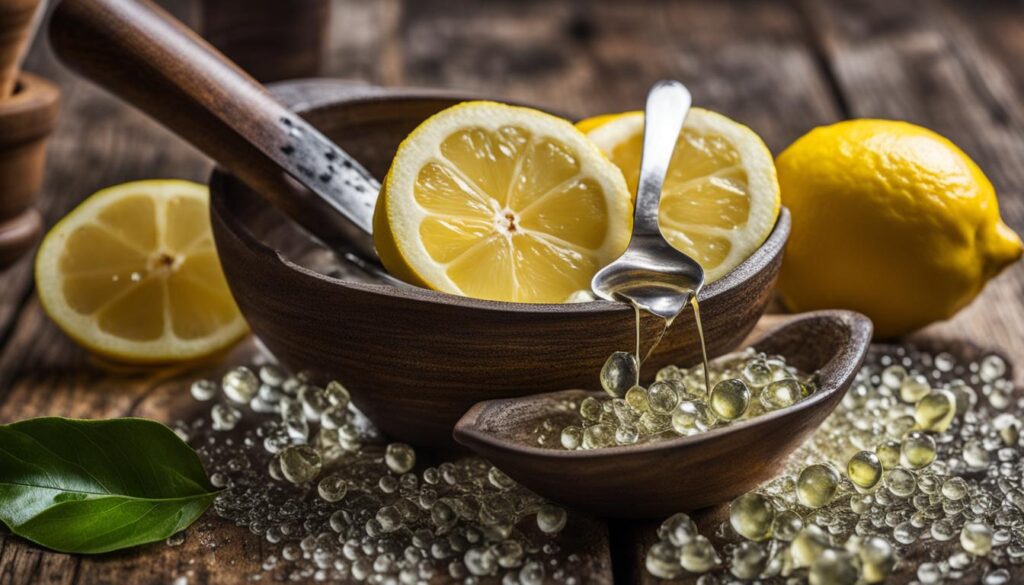Are you interested in making your own citric acid at home? Whether you’re a candy maker, a DIY enthusiast, or simply enjoy exploring new recipes, learning how to make citric acid can open up a world of possibilities. In this guide, I will provide easy step-by-step instructions and helpful tips for producing homemade citric acid.
Citric acid is a versatile ingredient that finds its use in various applications. From adding sourness to candies to acting as a natural preservative, citric acid has become a staple ingredient for many homemade creations. By making citric acid at home, you have full control over the quality and quantity of the product, ensuring that you’re using a pure and natural ingredient.
Key Takeaways:
- Learn how to make citric acid at home and explore its many uses.
- Discover the properties of citric acid and its benefits in candy making.
- Find out how to extract citric acid from lemons and make a citric acid solution.
- Get expert tips for successful candy making with citric acid.
- Understand the wide range of applications and benefits of citric acid beyond candy making.
What is Citric Acid and its Properties?
Citric acid is a weak organic acid found naturally in citrus fruits. It is commonly used in candy making to add sourness. Understanding citric acid and its properties is essential for harnessing its potential in various applications.
One of the key properties of citric acid is its notable strength. Despite being a weak acid, a little goes a long way. This makes it an economical choice for souring candies and other food products.
“Citric acid is a versatile ingredient that provides a tangy and refreshing taste to many dishes. Its ability to enhance flavors and preserve food has made it popular in both culinary and industrial applications.”
In addition to its taste-enhancing properties, citric acid also acts as a natural preservative. Its acidic nature creates an inhospitable environment for bacteria and molds, helping to extend the shelf life of food products.
Citric acid is available in a powdered form, making it easy to measure and incorporate into recipes. Its solubility in water allows for even distribution, ensuring a consistent taste throughout the final product.
Overall, understanding citric acid and its properties opens up a world of possibilities in various industries, including food, cosmetics, and cleaning products. Its versatility and effectiveness make it a valuable ingredient for both professional and homemade applications.
Making Citric Acid from Lemons
If you’re interested in making your own citric acid, one method involves extracting it from lemons. This process allows you to create a natural and homemade citric acid solution that can be used in various applications.
Here’s a step-by-step guide on how to extract citric acid from lemons:
- First, start by testing the pH of lemon juice to ensure it falls between 2 and 3. This acidity level is ideal for extracting citric acid efficiently.
- Next, add sodium hydroxide to raise the pH to around 8 or 9. This helps to initiate the extraction process.
- Filter the mixture to remove any impurities and combine it with a calcium chloride solution. This step helps in forming calcium citrate, a precursor to citric acid.
- Boil the mixture to dissolve the calcium citrate and separate it using a filter. This process helps to remove any unreacted materials and obtain a purer citric acid solution.
- Add diluted sulfuric acid to the calcium citrate solution, which causes a chemical reaction that releases citric acid.
- Filter the solution once again to remove any solid particles and heat it to evaporate excess liquid. This process allows for the concentration of citric acid.
- Finally, you will be left with citric acid crystals that can be stored for future use or further processed into a powdered form.
It’s important to note that the extraction of citric acid from lemons requires proper safety precautions and knowledge of handling chemicals. Always use protective gear such as gloves and goggles when working with chemicals, and ensure proper ventilation in your workspace.
This method provides an alternative to commercially produced citric acid and allows you to have more control over the quality and sourcing of the ingredient.

Benefits of Making Citric Acid from Lemons
Extracting citric acid from lemons offers several benefits:
“Making citric acid from lemons allows you to create a natural and chemical-free alternative to commercially produced citric acid. It gives you control over the sourcing and quality of the ingredient, making it an appealing option for those who prefer homemade and eco-friendly solutions.” – Expert in Citric Acid Extraction
| Benefits | Explanation |
|---|---|
| Chemical-free alternative | By extracting citric acid from lemons, you can avoid the potential chemical additives and impurities found in some commercially produced citric acid. |
| Control over sourcing and quality |
When you make citric acid from lemons, you have control over the lemons used, ensuring they are organic or from trusted sources. This allows you to create a higher quality product. |
| Eco-friendly solution | Making citric acid from lemons reduces the need for manufacturing processes associated with commercial production, contributing to a more sustainable and eco-friendly approach. |
By following this method, you can extract citric acid from lemons, empowering you to create your own homemade and natural citric acid solution.
Making Citric Acid Solution
If you prefer a liquid form of citric acid for your DIY projects or recipes, making a citric acid solution is a convenient option. By dissolving citric acid crystals in distilled water, you can create a concentrated solution that can be easily stored.
The recommended ratio for making a citric acid solution is 1 pound of citric acid powder to 1 pint of water. However, if you prefer a lower concentration solution, you can adjust the ratio accordingly.
To begin, boil the distilled water to ensure it is sterilized. Once the water reaches a rolling boil, carefully pour it over the citric acid crystals in a heat-resistant container. Stir the mixture vigorously until the citric acid is fully dissolved.

After the citric acid is fully dissolved, you may notice a clear liquid with a slightly sour scent. This indicates that the solution is ready for further use.
To remove any undissolved particles or impurities, it is recommended to filter the solution using a fine-mesh strainer or a coffee filter. This step ensures that your citric acid solution is smooth and free from any unwanted residue.
Once filtered, transfer the citric acid solution to an airtight container for storage. It is important to store the solution in a cool, dry place away from direct sunlight to maintain its potency and quality.
Having a homemade citric acid solution on hand gives you the flexibility to easily incorporate citric acid into your various projects and recipes. Whether you need to add a touch of acidity to your culinary creations or utilize citric acid’s cleaning properties, this solution provides a convenient way to access the benefits of citric acid.
Using Citric Acid in Candy Making
Citric acid is a fantastic ingredient for adding sourness to homemade candies. When your basic candy mixture reaches the hard-crack stage, it’s time to incorporate the tangy flavor of citric acid.
Here’s how you can use citric acid in your candy-making process:
- Dissolve citric acid.
- Mix thoroughly.
- Pour into molds.
- Let it set.
- Add a final touch.
Dissolve the desired amount of citric acid in a small amount of warm water. This step ensures that the citric acid blends evenly throughout the candy mixture.
Add the dissolved citric acid to the candy mixture and stir well. This ensures that the sourness is distributed evenly, giving every bite a delightful tang.
Pour the candy mixture into candy molds of your choice. You can use various shapes and sizes to create unique treats.
Allow the candy mixture to cool and set completely. This process typically takes a few hours or overnight, depending on the recipe.
For an extra burst of sourness, sprinkle additional citric acid on the surface of the candies before they fully harden. This adds a stunning visual appeal and an intensified tanginess.
With these simple steps, you can elevate your homemade candies with the sour kick of citric acid. The combination of sweetness and tanginess is sure to make your taste buds dance with delight!
Check out the table below for a quick overview of the candy-making process with citric acid:
| Steps | Description |
|---|---|
| 1 | Dissolve citric acid |
| 2 | Mix thoroughly |
| 3 | Pour into molds |
| 4 | Let it set |
| 5 | Add a final touch |
Remember, citric acid offers endless possibilities for creating deliciously sour candies. Experiment with different flavors and shapes to unleash your creativity in the kitchen!
 Disclaimer: It’s important to follow proper candy-making guidelines and safety precautions when working with citric acid or any other food ingredients.
Disclaimer: It’s important to follow proper candy-making guidelines and safety precautions when working with citric acid or any other food ingredients.
Tips for Success in Making Sour Candy
When making sour candies with citric acid, there are a few important tips to keep in mind for a successful candy-making experience. By following these tips, you can ensure that your candies turn out sour, flavorful, and safe to eat.
1. Use Food-Grade Citric Acid
It is crucial to use food-grade citric acid when making sour candies. Food-grade citric acid is specifically produced for culinary use and undergoes strict quality controls to ensure its safety and purity. Using food-grade citric acid guarantees that your candies will have the desired level of sourness without any harmful impurities.
2. Handle Hot Candy Mixtures with Care
When working with hot candy mixtures, exercise caution to avoid burns. Use heat-resistant gloves or mitts to protect your hands when handling hot syrup or melted candy. Hot mixtures can cause severe burns, so it’s essential to take extra care when working with them.
3. Experiment with Citric Acid Amounts
The amount of citric acid you add to your candy mixture determines the level of sourness. Start by adding a small amount of citric acid and taste the mixture. If you want a more intense sour flavor, gradually add more citric acid until you achieve your desired taste. Remember, citric acid is potent, so a little goes a long way.
4. Add Citric Acid at the Right Temperature
The optimal time to add citric acid to your candy mixture is when it reaches the appropriate temperature. Different candy recipes have different temperature requirements. Follow your specific recipe instructions and add the citric acid when the mixture is at the recommended temperature. This allows the citric acid to dissolve properly and evenly distribute its sourness throughout the candies.
By following these tips, you can create deliciously sour candies that are sure to tantalize your taste buds. Experiment with different flavors, shapes, and textures to unleash your creativity and enjoy the satisfaction of successful candy making with citric acid.
Citric Acid Uses and Benefits
Aside from its role in candy making, citric acid has a wide range of uses and benefits in various industries. Let’s explore some of its versatile applications:
Cleaning Products
Citric acid is a common ingredient in many cleaning products and household cleaners. Its acidic properties make it effective in removing stains, mineral deposits, and hard water buildup. Whether you’re tackling stubborn bathroom grime or descaling your coffee maker, citric acid can help make your cleaning efforts easier and more efficient.
Cosmetics
Citric acid is often utilized in cosmetic products for its exfoliating and brightening properties. It helps to remove dead skin cells, promote cell turnover, and improve the overall texture and appearance of the skin. Additionally, citric acid is a natural antioxidant that can help protect the skin from environmental damage.
Food Preservation
As a natural preservative, citric acid is commonly used in the food industry to extend the shelf life of various products. It helps inhibit the growth of bacteria, fungi, and mold, keeping foods fresher for longer. Citric acid is particularly beneficial in preserving fruits, vegetables, and canned goods.
Other Uses
Citric acid finds its way into a multitude of other applications. It is used in the production of certain medications, as a flavor enhancer in the food and beverage industry, and as a chelating agent in the textile and detergent industries. Its versatility and effectiveness make citric acid a valuable ingredient in many products across various sectors.
| Citric Acid Uses | Citric Acid Benefits |
|---|---|
| In cleaning products | Effectively removes stains and mineral deposits |
| In cosmetics | Exfoliates and brightens the skin |
| In food preservation | Extends the shelf life of products |
| In medication production | Used as an active ingredient in certain medications |
| In the food industry | Enhances flavor in various foods and beverages |
| In the textile industry | Serves as a chelating agent in detergent production |
Conclusion
By following this guide, you can easily make homemade citric acid and explore its numerous applications. Whether you’re adding a sour kick to your favorite candies or searching for a natural cleaning solution, citric acid is a versatile ingredient that offers a range of benefits.
Creating citric acid from lemons or dissolving citric acid crystals in water allows you to harness its sourness and incorporate it into your culinary creations. With careful experimentation, you can adjust the amount of citric acid to achieve the desired level of tartness.
Furthermore, citric acid extends beyond candy making. Its presence in cleaning products, cosmetics, and food preservation demonstrates its versatility. You can utilize citric acid to remove stains, descale appliances, and promote healthy skin.
Unleash your creativity and enjoy the benefits of homemade citric acid. From tantalizing taste buds to maintaining a clean and vibrant space, this humble ingredient will elevate your everyday experiences.
FAQ
How can I make citric acid at home?
There are a couple of methods to make citric acid at home. One method involves extracting it from lemons, while another method involves dissolving citric acid crystals in distilled water.
How do I extract citric acid from lemons?
To extract citric acid from lemons, you can start by testing the pH of lemon juice, then add sodium hydroxide to raise the pH, filter the mixture, combine it with a calcium chloride solution, boil the mixture, separate the calcium citrate using a filter, add diluted sulfuric acid, filter the solution again, and heat it to evaporate excess liquid to obtain citric acid.
What is the process of making a citric acid solution?
To make a citric acid solution, you can dissolve citric acid crystals in distilled water. The recommended ratio is 1 pound of citric acid powder to 1 pint of water. Boil the water and pour it over the citric acid, stirring until fully dissolved. Filter the solution and transfer it to an airtight container for storage.
Can I use citric acid in candy making? How?
Yes, citric acid is commonly used in candy making to add sourness. Once your basic candy mixture reaches the hard-crack stage, you can add dissolved citric acid. Stir well to distribute the sourness evenly. Pour the mixture into candy molds and let it set. For an extra sour kick, you can sprinkle citric acid on the surface of the candies before they fully harden.
Are there any tips for successful candy making with citric acid?
Yes, when making sour candies with citric acid, use food-grade citric acid. Be cautious when handling hot candy mixtures to avoid burns. Experiment with the amount of citric acid to achieve the desired level of sourness. Add the citric acid at the appropriate temperature for optimal results.
What are the uses and benefits of citric acid?
Citric acid has various uses beyond candy making. It is a common ingredient in cleaning products, cosmetics, and food preservation. It can also help remove stains, descale appliances, and improve skin health.






